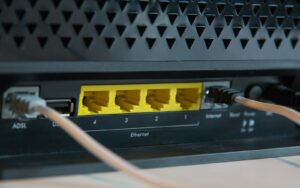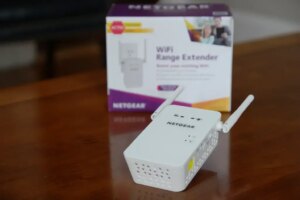If you’re looking for the most secure Wi-Fi, skip straight to WPA3. It’s the latest protocol and the toughest to crack. If your devices don’t support it, use WPA2. Avoid outdated WEP and WPA, as they are vulnerable to hacking.
WEP vs WPA vs WPA2 vs WPA3: WEP is outdated and insecure, WPA is an improvement but still vulnerable, WPA2 is currently the most widely used protocol but has some vulnerabilities, and WPA3 offers the best security but faces adoption challenges due to device compatibility and infrastructure support issues.
Let’s explore why these are the best choices in the rest of this article.
WEP vs WPA vs WPA2 vs WPA3 – Comparison Table
| Feature | WEP | WPA | WPA2 | WPA3 |
|---|---|---|---|---|
| Full Name | Wired Equivalent Privacy | Wi-Fi Protected Access | Wi-Fi Protected Access 2 | Wi-Fi Protected Access 3 |
| Release Year | 1999 | 2003 | 2004 | 2018 |
| Encryption | 64-bit or 128-bit RC4 | 128-bit RC4 (TKIP) | 128-bit or 256-bit AES (CCMP) | 128-bit (WPA3-Personal) or 192-bit (WPA3-Enterprise) |
| Key Management | Static keys | Dynamic keys | Dynamic keys | Dynamic keys (unique keys, individualized data encryption) |
| Authentication | Open System Authentication or Shared Key Authentication | WPA-Personal (PSK) or WPA-Enterprise (802.1X/EAP) | WPA2-Personal (PSK) or WPA2-Enterprise (802.1X/EAP) | WPA3-Personal (SAE) or WPA3-Enterprise (802.1X/EAP) |
| Vulnerability | Highly vulnerable to attacks, keys can be cracked easily | Vulnerable to certain attacks, should be replaced by WPA2 | More secure than WEP and WPA, but still has some vulnerabilities (e.g., KRACK attack) | Most secure, protects against dictionary attacks, brute force attacks, and provides forward secrecy |
| Recommended Usage | Should not be used due to weak security | Should be replaced by WPA2 or WPA3 | Currently the most widely used protocol, but should be upgraded to WPA3 when possible | Recommended for the best security, but may have compatibility issues with older devices |
| Transition Period | Replaced by WPA | Replaced by WPA2 | Slowly being replaced by WPA3 | Gradually being adopted, but faces challenges due to device incompatibility and lack of infrastructure support |
| Protected Management Frames (PMF) | Not supported | Not supported | Mandated support since early 2018 (older routers with unpatched firmware may not support PMF) | Mandates use of PMF |
Key Takeaways
- WEP is outdated and insecure, and should be avoided.
- WPA is an improvement over WEP but still has vulnerabilities.
- WPA2 is currently the most widely used protocol and provides strong security.
- WPA3 is the latest and most secure protocol, but faces adoption and compatibility challenges.
- Always use the strongest available protocol (preferably WPA2 or WPA3) with a strong, unique password.
- Enable network encryption and regularly update your devices to ensure the best possible security.
- Be cautious when using open, unsecured Wi-Fi networks in public places, and use a VPN for added protection.
WEP (Wired Equivalent Privacy)
WEP was the first Wi-Fi security protocol, introduced in 1997. It uses the RC4 encryption algorithm with either 64-bit or 128-bit key lengths. However, WEP has several well-known vulnerabilities that make it easy for hackers to crack the encryption and gain unauthorized access to your network.
Some of the main weaknesses of WEP include:
- Weak encryption: The RC4 algorithm used by WEP is relatively easy to crack, especially with modern computing power.
- Poor authentication: WEP does not provide strong user authentication, making it possible for attackers to connect to your network without proper credentials.
- Static keys: WEP keys are static and need to be manually changed, which can be a hassle for users and administrators.
Due to these vulnerabilities, WEP is no longer recommended and should be avoided whenever possible. If you’re still using WEP, it’s crucial to upgrade to a more secure protocol like WPA2 or WPA3.
WPA (Wi-Fi Protected Access)
WPA was introduced in 2003 as a successor to WEP. It aimed to address the security flaws found in WEP while maintaining backward compatibility with older devices. WPA uses the Temporal Key Integrity Protocol (TKIP) for encryption, which is more secure than RC4. It also supports 256-bit encryption, providing a higher level of security compared to WEP.
WPA comes in two flavors:
- WPA-Personal (also known as WPA-PSK): This mode uses a pre-shared key (PSK) for authentication. The PSK is a password that all devices use to connect to the network.
- WPA-Enterprise (also known as WPA-EAP): This mode uses the Extensible Authentication Protocol (EAP) for authentication, which requires a RADIUS server to verify user credentials.
While WPA is a significant improvement over WEP, it still has some vulnerabilities. For example, the TKIP encryption can be cracked using advanced techniques like the Beck-Tews attack. As a result, WPA has been largely superseded by WPA2.
WPA2 (Wi-Fi Protected Access 2)
WPA2 is the successor to WPA and was ratified in 2004. It is currently the most widely used Wi-Fi security protocol. The main improvement in WPA2 is the use of the Advanced Encryption Standard (AES) with the Counter Mode Cipher Block Chaining Message Authentication Code Protocol (CCMP). This combination provides much stronger encryption compared to TKIP.
Like WPA, WPA2 also has two modes:
- WPA2-Personal (WPA2-PSK): This mode uses a pre-shared key for authentication, similar to WPA-Personal.
- WPA2-Enterprise (WPA2-EAP): This mode uses the Extensible Authentication Protocol (EAP) for authentication, similar to WPA-Enterprise.
While WPA2 is generally considered secure, it is not without its flaws. In 2017, researchers discovered the KRACK (Key Reinstallation Attack) vulnerability, which allows attackers to intercept and decrypt Wi-Fi traffic. However, this vulnerability can be mitigated by applying the appropriate patches and updates to your devices and routers.
It’s worth noting that using WPA2 may slightly impact your Wi-Fi speed compared to WEP or WPA, as the stronger encryption requires more processing power. However, the difference is usually negligible on modern devices.
WPA3 (Wi-Fi Protected Access 3)
WPA3 is the latest Wi-Fi security protocol, introduced in 2018. It builds upon the security features of WPA2 while adding new enhancements to protect against evolving threats. Some of the key features of WPA3 include:
- Improved protection against brute-force attacks: WPA3 uses the Simultaneous Authentication of Equals (SAE) method, which makes it much harder for attackers to guess passwords by trying multiple combinations.
- Forward secrecy: WPA3 generates unique encryption keys for each session, ensuring that even if an attacker manages to crack one session, they cannot decrypt data from previous or future sessions.
- Increased encryption key sizes: WPA3 supports 192-bit and 256-bit encryption keys, providing an even higher level of security compared to WPA2.
However, WPA3 adoption has been slow due to several factors:
- Device compatibility: Many older devices do not support WPA3, which can lead to compatibility issues when upgrading your network.
- Infrastructure support: Not all routers and access points currently support WPA3, which means you may need to purchase new hardware to take advantage of the latest security features.
- Performance impact: The stronger encryption used in WPA3 may slightly impact Wi-Fi speed, especially on older or less powerful devices.
Despite these challenges, WPA3 is expected to become the new standard for Wi-Fi security in the coming years. As more devices and infrastructure support WPA3, it will become easier to implement and take advantage of its enhanced security features.
Best Practices for Wi-Fi Security
To ensure the best possible security for your wireless network, follow these best practices:
- Use WPA3 whenever possible. If your devices and infrastructure support WPA3, enable it to take advantage of the latest security features.
- If WPA3 is not available, use WPA2 with a strong, unique password and AES encryption. Avoid using WEP or WPA, as they have known vulnerabilities.
- Enable network encryption on your router or access point. This will help protect your data from eavesdroppers and attackers.
- Regularly update your router’s firmware to ensure you have the latest security patches and features.
- Use a strong, unique password for your Wi-Fi network. Avoid using easily guessable passwords or sharing your password with others.
- Consider using a VPN (Virtual Private Network) for added security, especially when accessing sensitive information on public Wi-Fi networks.
Risks of Open Wi-Fi Networks
Open, unsecured Wi-Fi networks in public places like cafes, airports, and libraries can be convenient, but they also pose significant security risks. When you connect to an open Wi-Fi network, your data is transmitted in plain text, which means that anyone on the same network can potentially intercept and read your information.
Hackers can also use open Wi-Fi networks to distribute malware, steal sensitive information, or perform man-in-the-middle attacks. To protect yourself when using public Wi-Fi, follow these tips:
- Avoid accessing sensitive information (e.g., online banking, email) on open Wi-Fi networks.
- Use a VPN to encrypt your data and protect your privacy.
- Enable your device’s built-in firewall and use anti-malware software.
- If possible, use your mobile data connection instead of public Wi-Fi for sensitive tasks.
To Conclude
In this article, we’ve explored the four main Wi-Fi security protocols: WEP, WPA, WPA2, and WPA3. We’ve discussed their differences in terms of encryption, key sizes, security features, and vulnerabilities, as well as their impact on network security, speed, and compatibility.
To recap, WEP is an outdated and insecure protocol that should be avoided. WPA is an improvement over WEP but still has vulnerabilities. WPA2 is currently the most widely used protocol and provides strong security, but it can be impacted by the KRACK vulnerability. WPA3 is the latest and most secure protocol, but it faces challenges in terms of adoption and compatibility.
As a user or network administrator, it’s crucial to stay informed about the latest developments in Wi-Fi security and to prioritize security when setting up and using wireless networks. By following best practices like using strong passwords, enabling encryption, and regularly updating your devices, you can help protect your data from potential threats.
Remember, no security protocol is perfect, and new vulnerabilities may be discovered over time. However, by understanding the strengths and weaknesses of each protocol and making informed decisions about your network security, you can significantly reduce the risk of falling victim to hackers and cybercriminals.
FAQs
- Q: What is the difference between WPA-Personal and WPA-Enterprise?
A: WPA-Personal uses a pre-shared key (PSK) for authentication, while WPA-Enterprise uses the Extensible Authentication Protocol (EAP) and requires a RADIUS server to verify user credentials. - Q: Can I use WPA and WPA2 simultaneously on my network?
A: Yes, most modern routers support mixed-mode configurations that allow both WPA and WPA2 devices to connect. However, it’s recommended to use WPA2 whenever possible for the best security. - Q: How often should I change my Wi-Fi password?
A: It’s a good practice to change your Wi-Fi password every few months, or whenever you suspect that your network may have been compromised. Use a strong, unique password that includes a mix of uppercase and lowercase letters, numbers, and special characters. - Q: What is the KRACK vulnerability, and how can I protect against it?
A: KRACK (Key Reinstallation Attack) is a vulnerability in the WPA2 protocol that allows attackers to intercept and decrypt Wi-Fi traffic. To protect against KRACK, ensure that all your devices and routers are updated with the latest security patches and firmware. - Q: Can using a stronger security protocol like WPA3 impact my Wi-Fi speed?
A: Yes, using a stronger security protocol like WPA3 may slightly impact your Wi-Fi speed, especially on older or less powerful devices. However, the difference is usually negligible on modern devices, and the added security is well worth the trade-off.




